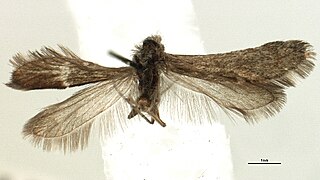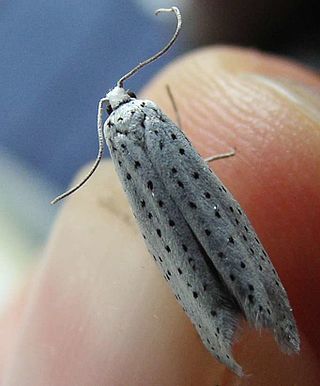
Heterobathmia is a genus of Lepidoptera. It is the only genus in the suborder Heterobathmiina, as well as in the superfamily Heterobathmioidea and in the family Heterobathmiidae. Primitive, day-flying, metallic moths confined to southern South America, the adults eat the pollen of Nothofagus or southern beech and the larvae mine the leaves. Most known species are undescribed.
Sir George Francis Hampson, 10th Baronet was an English entomologist.

Urodidae, whose species are commonly known as false burnet moths, is a family of moths in the lepidopteran order. It is the type genus in the superfamily, Urodoidea, with three genera, one of which, Wockia, occurs in Europe.
Metachanda is the sole genus in tribe Metachandini of moth subfamily Oecophorinae. Metachandini was originally described as family Metachandidae by Edward Meyrick in 1911, and at the time also contained the genus Chanystis, which is currently unplaced to tribe within Oecophorinae. It has also previously been described as tribe Metachandini of subfamily Gelechiinae.

Agathiphaga is a genus of moths, known as kauri moths. and is the only living genus in the family Agathiphagidae. This caddisfly-like lineage of primitive moths was first reported by Lionel Jack Dumbleton in 1952, as a new genus of Micropterigidae.

Yponomeutinae is a subfamily of "micromoths" in the lepidopteran family Yponomeutidae. As their scientific name implies, this is the subfamily containing the type genus of the ermine moths, Yponomeuta. The subfamily has worldwide distribution.

The Thyatirinae, or false owlet moths, are a subfamily of the moth family Drepanidae with about 200 species described. Until recently, most classifications treated this group as a separate family called Thyatiridae.
Lamprostola is a genus of moths in the subfamily Arctiinae described by William Schaus in 1899.

Coxina is a genus of moths in the family Erebidae, found in North, Central, and South America.

Heterochroma is a genus of moths of the family Noctuidae. The genus was erected by Achille Guenée in 1852.
Oxidercia is a genus of moths of the family Erebidae. The genus was erected by Jacob Hübner in 1825.
Radara is a genus of moths of the family Erebidae. The genus was erected by Francis Walker in 1862.
Celonoptera is a monotypic moth genus in the family Geometridae. Its only species, Celonoptera mirificaria, is found in south-eastern Europe. Both the genus and species were first described by Julius Lederer in 1862.
Lamprostola aglaope is a moth of the subfamily Arctiinae. It was described by Felder in 1875. It is found in Mexico, Guatemala, Costa Rica and the Amazon region.
Lamprostola endochrysis is a moth of the subfamily Arctiinae. It was described by Paul Dognin in 1909. It is found in Colombia.
Lamprostola nitens is a moth of the subfamily Arctiinae. It was described by George Hampson in 1900. It is found in Bolivia.
Lamprostola olivacea is a moth of the subfamily Arctiinae. It was described by Schaus in 1896. It is found in São Paulo, Brazil.
Lamprostola molybdipera is a moth of the subfamily Arctiinae. It was described by William Schaus in 1899. It is found in Mexico. Its thorax, primaries, and head are all dark greenish black with a hint of iridescence; the veins are still darker. The secondaries and abdomen are dull brownish black.
Lamprostola pascuala is a moth of the subfamily Arctiinae. It was described by Schaus in 1896. It is found in São Paulo, Brazil.
Lamprostola unifasciella is a moth of the subfamily Arctiinae. It was described by Strand in 1922. It is found in Colombia.






